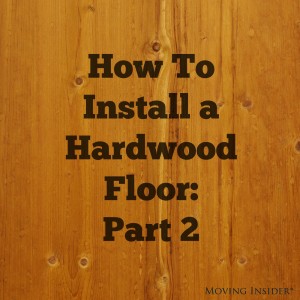 Did you decide to install a hardwood floor yourself? Installing a hardwood floor is a great way to improve and change the look of your home. In part one of this series, we discussed choosing DIY vs professional installation and deciding what type of flooring you want. You can read more about it here.
Did you decide to install a hardwood floor yourself? Installing a hardwood floor is a great way to improve and change the look of your home. In part one of this series, we discussed choosing DIY vs professional installation and deciding what type of flooring you want. You can read more about it here.
Preparing for Installation
First, you will need to make sure the area is empty. If you are currently living in your home then you may want portable storage so you can store your possessions and have them delivered back to your door when your project is complete. Then make sure your floor is ready. Any padding or moisture barriers as applicable should be laid, and you will want to sweep or vacuum the area and ensure that it is clean.
 Purchase and Delivery of Flooring
Purchase and Delivery of Flooring
You will need to purchase your flooring. Have your square footage calculated and be sure to buy extra for installation mistakes, pieces that will need to be cut, natural variations, and future replacement. If delivery is not included, you will want to arrange for a trailer or rental truck to transport it to your home. Remember not to overload your vehicle or trailer. Wood can be dense and heavy.
Installing the Hardwood Floor
Once you have the flooring in your home you will need to let it acclimate for at least 3 days. Wood is an organic material, and it will warp and change with the climate, conditions and time.
Remember to follow the manufacturers instructions. Reading them thoroughly can save you time and aggravation later. Different flooring has different features and installation methods.
You will want to start from the longest straightest wall in the area you will be laying the flooring and work out from there. Also, don’t forget to use the manufacturer recommended spacers against the wall. That will allow your wood floor space to expand and contract as natural materials like wood will do.
You may want to save the best or most uniform wood for areas that are high visibility. Lower quality boards can be used in areas that will be covered by furniture or rugs. Wood with imperfections can be saved to be used where boards will be cut for length or width to fit certain areas of your home.
Measure twice. Cut once. An old, but important rule. You don’t want to waste expensive flooring just because you mismeasured. Accidents will happen, but minimizing mistakes will save you time and money.
Did you install a hardwood floor in your home? How did it turn out? Let us know any tips or tricks you discovered in our comment section.



